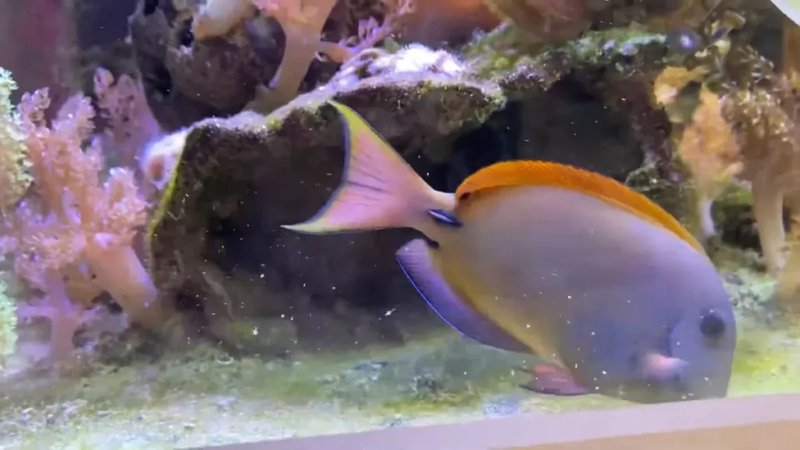
Tangs, especially popular species like the yellow tang and blue tang, have specific dietary needs and preferences that make them unique in the fish community. Their feeding habits can tell us a lot about their general health, behavior, and even their compatibility with other fish. Let’s dive into the world of tang fish feeding, exploring everything from what they eat to how you can replicate their natural diet in your aquarium.
Understanding Tang Fish Diet
Tang fish are primarily herbivores, meaning they thrive on a diet rich in plant material. At the core of their nutrition, these fish prefer algae, which they graze on from rocks and coral in their natural habitat. Think of a gourmet salad bar; that’s how they approach their meals! Algae come in many varieties, and their preference can depend on the species and environment.
Some key types of algae that tangs love include:
- Green algae: This is often the staple of their diet, providing essential nutrients.
- Brown algae: Also known as diatoms, these are usually more prevalent in younger aquariums.
- Red algae: These are less common but still a treat for tangs!
Understanding this natural preference is crucial for anyone looking to keep tangs healthy and happy in an aquarium.
Feeding Tang Fish in Aquariums
Bringing tang fish into your home aquarium is exciting, but it also comes with the responsibility of replicating their natural diet as closely as possible. You might be wondering what this means for your routine. The good news is that there are various ways to feed your tangs, and it’s easier than you might think.
First off, you can use commercial algae sheets. These sheets are dried and packaged for easy feeding. You can simply clip them to the side of the tank, and your tangs will go to town. Another option is to provide fresh vegetables such as spinach, zucchini, or seaweed. Just make sure to blanch them first to make them easier to eat.
Here’s a quick checklist to make feeding easy:
- Use high-quality algae sheets or fresh vegetables.
- Feed them 1-2 times a day, but only offer what they’ll eat in a few minutes.
- Remove uneaten food to maintain water quality.
Feeding your tangs properly helps them thrive in your aquarium and prevents them from developing health issues.
How Often Should You Feed Tang Fish?
Feeding frequency can affect the overall health of your tang fish, and it’s essential to get this right. You might think, “More food means happier fish,” but that’s not always the case. Overfeeding can lead to obesity and other health issues.
Most experts recommend feeding tangs twice a day—once in the morning and once in the evening. Here’s a simple breakdown:
– Morning: Start with a small amount of algae or vegetables. Monitor how much they consume within a few minutes.
– Evening: Offer a second serving, adjusting based on what they ate earlier.
You might find that young tangs are more voracious eaters than adults. As they grow, their appetite may lessen, so it’s always good to pay attention to their feeding habits.
Variety in the Diet
Just like you wouldn’t want to eat the same meal every day, tangs benefit from a varied diet too. A mix of foods can help ensure they receive all necessary nutrients. You can mix and match commercial foods and fresh offerings to spice things up.
Here’s a list of ideas to keep their menu exciting:
- Dried seaweed: Rotate different types to keep things interesting.
- Frozen foods: Options like brine shrimp or mysis shrimp can be excellent protein sources.
- Vegetable blends: You can blend a variety of vegetables and freeze them in cubes for easy feeding.
By providing a variety of foods, you ensure your tangs stay engaged during feeding time and receive balanced nutrition.
Recognizing Feeding Issues
Feeding tang fish might seem straightforward, but sometimes fish can exhibit unusual behavior or dietary issues. You might notice your tang not eating as much or showing signs of stress. It’s essential to know the red flags.
A sudden change in appetite can indicate:
– Stress: New tank mates or changes in water quality can make tangs uneasy.
– Illness: If they’re not eating and showing symptoms like lethargy, it could be a sign of disease.
– Boredom: If they’re used to a certain diet and that changes, they may refuse to eat as a result.
If you suspect any feeding issues, always check your tank conditions—temperature, pH, and cleanliness play vital roles in fish behavior.
Health Benefits of Proper Feeding
Maintaining a healthy diet is key to increasing the lifespan and vitality of tang fish. Honestly, tangs can thrive for many years if their needs are met. Proper nutrition supports their immune system and helps prevent diseases.
By sticking to a reliable feeding schedule and incorporating a variety of foods, you’re actively contributing to:
– Coloration: A balanced diet can enhance their vibrant colors, making them stunning highlights in your aquarium.
– Longer Lifespan: Healthy tangs can live up to 15 years or more in captivity!
– Better Behavior: Well-fed fish are usually more active and social, enhancing the enjoyment of your aquarium.
So, by understanding and implementing proper feeding habits, you’re not just keeping fish alive—you’re helping them flourish!
The diet and feeding habits of tang fish are essential for their overall well-being and happiness. By providing a varied and balanced diet, you can ensure your tangs not only survive but thrive in your aquarium. Remember, these colorful fish bring life to your underwater world, and caring for their dietary needs is a vital part of that experience.
Next time you sit down to feed your tangs, think of the vibrant reef they come from and the rich menu they’re used to. With the right care, you’ll see their colors pop and their personalities shine. So gear up, get those algae sheets ready, and watch your tangs enjoy every bite!

